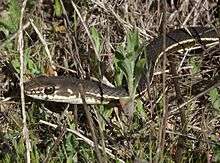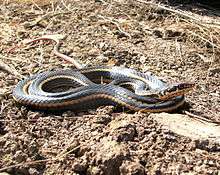California whipsnake
The California whipsnake (Masticophis lateralis) also known as the striped racer, is a colubrid snake found in habitats of the coast, desert, and foothills of California.
| California whipsnake | |
|---|---|
 | |
| Masticophis lateralis lateralis, chaparral whipsnake subspecies | |
| Scientific classification | |
| Kingdom: | Animalia |
| Phylum: | Chordata |
| Class: | Reptilia |
| Order: | Squamata |
| Suborder: | Serpentes |
| Family: | Colubridae |
| Genus: | Masticophis |
| Species: | M. lateralis |
| Binomial name | |
| Masticophis lateralis (Hallowell, 1853) | |
| Synonyms[1][2] | |
Description
Masticophis lateralis is 90–120 centimetres (3.0–3.9 ft) in total length (including tail). It is slender, with a yellowish stripe along each side, set against a dark brown or black back.[3]
Diet
The California whipsnake is known to eat a variety of live animals including insects, lizards, snakes, birds, and small mammals.[3][4] It shows a strong preference for lizards, which are captured by a grasp of the mouth,[4] and swallowed alive.
Behavior
Masticophis lateralis is fast-moving, diurnal, and an active forager. It commonly moves over and through brush and trees to avoid predation and to capture prey.[4] The California whipsnake has been observed moving into the top of scrub plants after emerging from nightly retreats to gain access to direct sunlight before the sunlight reaches ground level. It is not venomous, but likely to strike if captured.
Taxonomy
As with many species and subspecies, taxonomic reclassification is an ongoing process, and differing sources often disagree. The genus Masticophis may soon be absorbed by the closely related genus Coluber, which contains the racer (Coluber constrictor).
Subspecies
Masticophis lateralis has two subspecies:[3]
- M. l. lateralis (Hallowell, 1853) — chaparral whipsnake
- The chaparral whipsnake is a common subspecies in California and northern Baja California, Mexico. The subspecies is often associated with broken (variable) habitat types that range from northwestern to extreme southern California and further south into Northwestern Mexico.
- M. l. euryxanthus Riemer, 1954 — Alameda whipsnake
- The Alameda whipsnake subspecies is endemic to California. The subspecies is considered threatened there. Its range is relatively small, and much of the subspecies' habitat is threatened by development. It was first collected by Archie Mossman and later described by Riemer in 1954. The Alameda Whipsnake is a threatened species of colubrid snake distinguishable by its broad head, large eyes, black and orange coloring with a yellow stripe down each side, and a slender neck. The Alameda Whipsnake is a wary creature known for its speed and climbing abilities utilized when escaping predators or hunting prey. [4][5][6]

Nota bene: A trinomial authority in parentheses indicates that the subspecies was originally described in a genus other than Masticophis.
Habitat and geographic range
The California whipsnake, M. lateralis, is known to use a wide variety of habitat types including open desert, California oak woodland, pine forest, chaparral, and associated open landscape habitats.[3][7]
The geographic range of the Alameda whipsnake subspecies is contiguous in the area of southern Alameda County, northern Santa Clara County, and western San Joaquin County, in the southeastern Bay Area of Northern California.[8] It has commonly been reported as having a more specific association with chaparral and scrub plant communities as the habitat where it is most commonly found.[4][9][10]
The geographic range of the chaparral whipsnake subspecies has been reported to include woodlands, grasslands, chaparral scrublands, and riparian habitats.[4][7][11]
References
- Stejneger L, Barbour T (1917). A Check List of North American Amphibians and Reptiles. Cambridge, Massachusetts: Harvard University Press. 125 pp. (Coluber lateralis, p. 80).
- "Masticophis lateralis ". The Reptile Database. www.reptile-database.org.
- Stebbins RC (2003). A Field Guide to Western Reptiles and Amphibians, Third Edition. The Peterson Field Guide Series ®. Boston and New York: Houghton Mifflin Company. xiii + 533 pp., 56 plates. ISBN 978-0-395-98272-3. (Masticophis lateralis, pp. 353-354 + Plate 43 + Map 37).
- Swaim KE (1994). Aspects of the Ecology of the Alameda Whipsnake (Masticophis lateralis euryxanthus). Upublished Master's Thesis, California State University, Hayward. 140 pp.
- Alvarez JA (2006). "Masticophis lateralis euryxanthus (Alameda Whipsnake) habitat". Herpetological Review 37: 233.
- Alvarez JA (2005). "A compilation of observations of Alameda Whipsnake outside of typical habitat". Transactions of the Western Section of the Wildlife Society 41: 21-25.
- Ortenburger, Arthur Irving (1923). Whipsnakes and Racers: Genera Masticophis and Coluber. Norwood, Massachusetts: Plimpton Press. 247 pp.
- Jennings MR (1983). "Masticophis lateralis (Hallowel), Striped racer". Catalogue of American Amphibians and Reptiles. Society for the Study of Amphibians and Reptiles.
- Swaim KE, McGinnis SM (1992). "Habitat associations of the Alameda whipsnake". Transactions of the Western Section of The Wildlife Society 28: 107-111.
- United States Fish and Wildlife Service (2002). Draft recovery plan for chaparral and scrub community species east of San Francisco Bay, California. Portland, Oregon. xvi + 306 pp.
- Alvarez, pers. obs.
External links
| Wikimedia Commons has media related to Masticophis lateralis (California chaparra whipsnake). |
- The Nature Conservancy: Masticophis lateralis
- United State Fish and Wildlife Service (USFWS): Masticophis lateralis euryxanthus species Account — (Alameda Whipsnake).
- CaliforniaHerps.com: Masticophis lateralis euryxanthus — Alameda Striped Racer (Alameda whipsnake)
- CaliforniaHerps.com: Masticophis lateralis lateralis — California Striped Racer (Chaparral whipsnake)
Further reading
- Hallowell E (1853). "On some New Reptiles from California". Proc. Acad. Nat. Sci. Philadelphia 6: 236-238. (Leptophis lateralis, new species, p. 237).
- Riemer, William J. (1954). "A new subspecies of the snake Masticophis lateralis ". Copeia 1954 (1): 45-48. (Masticophis lateralis euryxanthus, new subspecies).
- Schmidt, Karl P.; Davis, D. Dwight (1941). Field Book of Snakes of the United States and Canada. New York: G.P. Putnam's Sons. 365 pp., 34 plates, 103 figures. (Coluber lateralis, pp. 127-129, Figure 30 + Plate 14).
- Smith, Hobart M.; Brodie, Edmund D., Jr. (1982). Reptiles of North America: A Guide to Field Identification. New York: Golden Press. 240 pp. ISBN 0-307-13666-3 (paperback), ISBN 0-307-47009-1 (hardcover). (Masticophis lateralis, pp. 190-191).
- Wright, Albert Hazen; Wright, Anna Allen (1957). Handbook of Snakes of the United States and Canada. Ithaca and London: Comstock Publishing Associates, a division of Cornell University Press. 1,105 pp. (in two volumes). (Masticophis lateralis, pp. 449-453, Figure 134 + Map 36 on p. 424).
